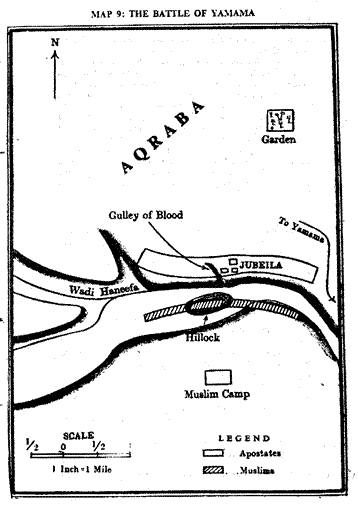|
A few days before the arrival
of Khalid, Musailima lost one of his ablest commanders-the chief,
Muja'a bin Marara, who has been mentioned as one of the important
members of the Bani Hanifa delegation to the Holy Prophet. This
man had set off with 40 riders to raid a neighbouring clan with
which he had an old feud. On its way back from the raid, the group
stopped for the night at a pass called Saniyat-ul-Yamamah, a day's
march from Aqraba. Muja'a's men slept soundly, but it was their
last sleep, for early in the morning the entire group was captured
by one of the mounted detachments which preceded the army of Khalid.
The apostates were taken before the Sword of Allah.
Khalid questioned them about their faith.
In whom did they believe? In Muhammad or in Musailima? Without exception
they remained unrepentant. Some sought to meet Khalid half way by
suggesting: "Let there be a prophet from among you and a
prophet from among us!" 1 Khalid
was not going to waste his time on such trash, he had them all beheaded
with the exception of the leader, Muja'a who was kept in chains
as a prisoner. He was a prominent chief and might come in useful
as a hostage. With this captive chief in tow, the Muslim army arrived
near Aqraba and pitched camp as has already been described. Both
armies were now ready for battle.
The actual valley of Wadi Hanifa marked
the battle front. On the northern side the bank rose to about 100
feet, rising gently at places, steeply at others, and precipitously
at yet others. On the southern side it rose more gently and continued
to rise up to a height of 200 feet, a mile away from the valley
where Khalid had pitched his camp. On the north bank also lay the
town of Jubaila and on the western edge of the town a gully ran
down to the wadi. The Muslim front ran along the southern bank for
a length of about 3 miles, on the northern bank stood the apostates.
The town and the gulley marked the centre of Musailima's army. Behind
the apostates stretched the plain of Aqraba; and on this plain,
about 2 miles from the wadi, stood a vast walled garden known
as Abaz. As a result of this battle it was to become known as "The
Garden of Death." 2 (See Map 9 below)

On the following morning the two armies
deployed for battle. Musailima organised his 40,000 men into a centre,
a left wing and a right wing. The left was under the command of
Rajjal, the renegade, the right under Muhakim bin Tufail, and the
centre directly under the Liar. In order to strengthen the determination
of the men, the son of Musailima, also named Shurahbil, rode in
front of all the regiments exhorting them to fight with courage.
"O Bani Hanifa" he called. "Fight today
for your honour. If you are defeated your women will be enslaved
and ravished by the enemy. Fight to defend your women!" 3
Musailima decided to await the attack of
Khalid. He would fight on the defensive initially, and go on to
the offensive when he had blunted the attack of his adversary and
thrown him off balance.
The Muslims had spent the night in prayer.
This was the largest and most fanatical enemy force they had ever
faced and its commander was the most vicious and cunning of men.
After the prayer of dawn Khalid drew up his 13,000 men for battle
on the south bank, and he too organised his army into a centre and
two wings. The left was commanded by Abu Hudeifa, the right by Zaid
(elder brother of Umar), while the centre was directly under Khalid.
For this battle Khalid formed his men not in tribal groups, as had
been the custom heretofore, but in regiments and wings as required
for battle, with tribal contingents intermingled.
Khalid planned, as was usual with him, to
attack at the very outset, throw his opponent on the defensive and
keep him that way. Thus Musailima would be robbed of his freedom
of manoeuvre and could do no more than react helplessly to the thrusts
of the attacker. But Khalid had no illusions about the trial that
faced the Muslims. This was going to be a bitter and bloody battle
as had never been fought before by the forces of Islam. The rebels
had a numerical superiority of three-to-one and were led by a wily
and brave general. But Khalid was confident of victory. He had confidence
in himself and in the skill and courage of his officers and men.
As he rode in front of his army, he looked with pride and satisfaction
at his stalwarts. There were famous men in this army, and some who
would rise to fame in later years. There was Zaid, brother of Umar,
and Abdullah, son of Umar. There was Abu Dujanah, who at Uhud had
shielded the Holy Prophet from the arrows of the enemy with his
body. There was the Caliph's son, Abdur-Rahman. There was Muawiyah,
son of Abu Sufyan, who would become the first caliph of the Umayyid
Dynasty. There was Um Ammarah, the lady who had fought beside the
Prophet at Uhud, with her son. And there was the Savage with his
deadly javelin.
1. Tabari: Vol. 2, p. 510.
2. The exact location of the Garden of Death
is not known. I have guessed its location from the course of the
battle.
3. Tabari: Vol. 2, p. 509.
|
